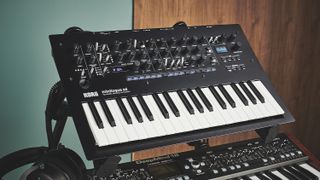In recent years, hardware synths have grown immensely in popularity as people look to make music outside of their DAW of choice. Hardware synths deliver a hands-on, tactile approach to synthesis, combined with easily tweakable parameters and, of course, great tones. So, whether you're looking for a pocket-sized instrument that can be powered by batteries, a powerful module or easy to play keyboard, we've got all the bases covered with this guide to the best cheap synthesizers - and we've even included the best synths under $500/£500 as well.
Now, it's fair to say you have more choice at the bottom end of the synth market than ever before, with analogue and digital options being well-represented at this price point. However, in terms of which is suitable for you, that's a matter of taste and functionality - in some cases, you don't even have to choose between the two, but we'll get to that.
So, whether you're looking for your first beginner synth, or a sound designer looking to add something new to your arsenal, there's a budget synth out there to suit everyone, and today we'll break down our favourites.
Best cheap synthesizers: MusicRadar's Choice
With a price point above $500/£500, it’s arguable that the Korg Minilogue XD is pushing the boundaries of what can be considered a ‘cheap’ synthesizer. That said, there’s no denying that it offers excellent value in terms of the sonic flexibility you get for your money. The original Minilogue already was - and, in fact, still is - a very versatile analogue synth.
By adding a customisable digital oscillator and effects slot on top of the original’s framework the XD takes things to the next level and has bags more character too. If you’re after one synth that can handle a variety of duties - bass, pads, percussion, FX - then this is the way to go.
As for one of the best synths under $500/£500, the Moog Werkstatt-01 is a definite contender. It comes unassembled, so there’s fun to be had in building it yourself, and once done it’s a quirky, fun way to make some amazing sounds for not a lot of money.
Best cheap synthesizer: Product guide
The original Minilogue is still a great buy, but if you can afford to spend a little more, we'd go for this pimped-up version that adds elements from the Monologue and Prologue synths as well. More versatile than the standard Minilogue, the XD offers a more powerful sequencer, greater versatility, a user-customisable digital Multi-Engine and effects, a joystick for real-time control, user scales/tunings and a vibe that's generally more inspiring.
The keys are of the 'slim' variety but still very playable, and the casing, which is made of metal with a wooden back panel, looks and feels great. Despite taking inspiration from elsewhere, The XD has a unique personality and is a is a hugely welcome addition to the 'logue range as a whole.
Read full Korg Minilogue XD review
Behringer’s synth arm might be best known for its controversy-courting ‘tributes’, but the German brand also has a couple of excellent original instruments under its belt. Following in the steps of last year’s Deepmind, Neutron is an analogue semi-modular that packs in a lot of flexibility for its very affordable price point.
The Neutron has a few flaws, and there are some frustrating design issues, but it does sound good, and in terms of bang-for-your-buck, you can't really beat it. While it does a very good job of creating more sensible sounds, it also excels at the weird and wonderful.
Read full Behringer Neutron review
Where the original was a fairly straightforward monosynth with a few unique touches and some CV control, the MiniBrute 2 is semi-modular, boasting a beefed- up synth engine and a comprehensive mini-jack patchbay. As before, the primary oscillator can generate saw, triangle and square waves simultaneously, the outputs of which are blended via the oscillator mixer, where they’re joined by a white noise source and external audio input.
Filter-wise, the MiniBrute 2 keeps the Steiner-Parker-style filter of its predecessor, which offers -12dB low- and high-pass modes, plus -6dB band-pass and notch filtering. On the whole, the MiniBrute 2 is a real success. It takes everything we liked about the original - the analogue grit, interesting oscillator shaping and Brute factor control, which overdrives the signal chain using a controlled feedback loop - and expands on it considerably. A serious competitor, then, and the same can be said of the MiniBrute 2S, which swaps the keys for a pad-based step sequencer.
Read full Arturia MiniBrute 2 review
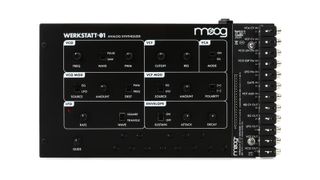
Originally conceived as a gift for attendees at a Moog event in 2014, the Werkstatt-01 proved so popular it has now received its own launch and is giving synth fans the chance to add a genuine Moog to their arsenal for under $/£200. For that you get a 100 percent analog monophonic synth with classic Moog filter, modulation and even a mini patch bay so you can experiment with modular synthesis or connect the Werkstatt up to a larger Eurorack system.
There are plenty of options in this guide with more in the way of features and functionality, but as a fun, inventive way of experimenting with modular synthesis the Werkstatt represents great value. You even get to build it yourself out of the box!
Circuit Mono Station is, in loose terms, a hybrid of two of Novation’s best instruments: a combination of the meaty analogue synth engine of the Bass Station II, and Circuit’s excellent sequencer. Housed in a chassis similar to - but slightly taller than - Circuit, Mono Station’s interface is roughly divided in half, with the upper section housing the synth controls and the lower portion controlling the sequencer.
Mono Station is equipped with a decent array of ins and outs, while the deep, multi-channel sequencer, flexible mod matrix and automation all add up to a workflow and creative experience unlike anything else on the market, combining the best of digital flexibility with a classic analogue synth design. The end result is much more than the sum of its parts, and at this price point this is a must-try synth.
Read full Novation Circuit Mono Station review
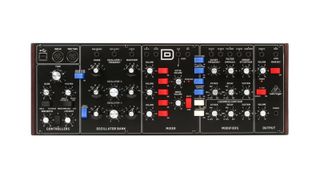
As one of the first ‘homage’ models off the Behringer photocopier, the Model D introduced a new generation of synth fans to the classic Minimoog sound while also adding in a few neat tricks of its own. Essentially, you get three oscillators, each with a variety of waveforms, a 24 dB ladder filter and basic modulation which makes for a rather splendid combination. We found the Model D equally adept at thick bass sounds, 80’s style pads and all kinds of experimental sonic mayhem.
We like the way Model D can be removed from its casing and installed in a Eurorack modular setup too, which makes use of the patch points across the top of the unit. It’s also good to see a variety of connectivity options, including MIDI in and thru, and USB for sending note data from a DAW. There’s a lot to like here, and for not a lot of cash either.
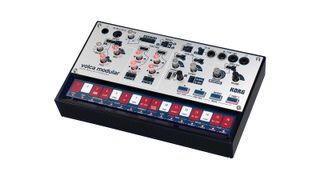
There are several impressive synths in Korg’s compact Volca range all of which boast sounds and feature that means it's hard to believe it's under $500/£500. Of the whole range though, the Volca Modular is certainly the most unique and interesting.
This patchable analogue synth takes its cues from ‘West Coast’ synthesizers such as those created by Buchla and Serge. These instruments eschew ‘traditional’ subtractive synthesis elements in favour of more esoteric features such as oscillators based around audio-rate modulation and random modulators.
Because of this, the Modular is the weirdest, and most niche instrument in the Volca range – it’s best for experimental sounds and unusual effects, meaning it won’t suit everyone. However, if you’re after something a bit different to add to your current setup, this is a great choice.
Read the full Korg Volca Modular review
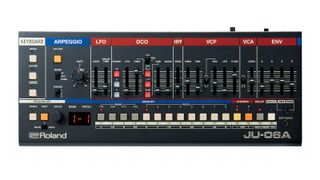
The JU-06A is an update to one of Roland’s original Boutique synths, the Juno-106-inspired JU-06. Like its predecessor, this latest synth uses digital Analog Circuit Behavior technology to replicate the components of the original Juno, and does an excellent job of capturing the feel and sound of Roland’s classic analogue poly (albeit with a voice count reduced from six to four).
The difference here is that the ‘A’ adds multiple elements of the Juno-60 into the mix too, including that synth’s well-regarded arpeggiator and a switch engaging the 60’s punchier, more percussive filter and envelope behaviour. The result is an altogether more versatile and impressive synth – the two modes add to the sonic flexibility considerably, and pairing the arp, chord mode and mono sequencer makes this a killer tool for classic Chicago and Detroit-style club sounds.
Read the full Roland JU-06A review
The only analogue instrument in Roland's Boutique line-up, the SE-02 was created in collaboration with Studio Electronics, which is responsible for - among many other things - the Tonestar and Boomstar instruments. It features three VCOs, a voltage-controlled 24dB low-pass filter, and a dual gain-stage amplifier. The oscillators have six different waveforms, which promise the “warmth and complex character” that you’d hope for.
Considering there’s also a nicely-featured sequencer onboard, the SE-02 is a very impressive piece of kit for the price. Sonically, it’s high-quality, and can do everything from warm and smooth to harsh and aggressive. It’s a bit Rolandy and a bit Moogy/SE-ish… but then with all the versatile modulation and shaping onboard it has its own vibe, too, and it’s hard to make it sound bad. Recommended for anyone who wants a great-sounding, portable and versatile monosynth for the studio and stage.
Read the full Roland SE-02 review
The look of UNO may prove a bit divisive. Its slanted profile and push button control panel have a retro charm, but it’s a design that brings to mind the early days of home computers more than any vintage analogue synth. The lower part of the push button interface is taken up by a 27-note ‘keyboard’ for live playing, or to input notes for the onboard sequencer or arpeggiator.
Despite all of this, UNO is an excellent-sounding, versatile analogue monosynth, and you do get a lot for your money. The presets offer a ton of highly usable sounds, and we could certainly see this becoming a go-to instrument for classic basses and leads. The arp and sequencer are great for inspiring ideas, and a software editor adds to the allure. if you can cope with a few compromises, UNO is a great source of classic, punchy analogue sounds at a bargain price.
Read full IK Multimedia UNO Synth review
Out of the box, MicroFreak’s unique stylings immediately grab your attention. It’s a bold look - but we like adventurous design choices. With so many synthesis features packed into such a small box, it’s hard not to fall in love with Arturia’s quirky and affordable hardware offering.
The multiple oscillator modes cover a near-endless range of timbres; the filter is smooth and versatile; the Matrix invites exploratory modulation; and the performance and sequencing tools are the icing on the creative cake. However, the real magic lies in the combo of all these together, making this odd little beast far more than the sum of its parts. MicroFreak should be top of your ‘must try’ list.
Read full Arturia MicroFreak review
What actually is the OP-Z? A synth? A sampler? An audio-visual sequencer? The answer is, to some extent at least, all of the above. At its core the OP-Z has a 16-track, 16-step sequencer. Of those tracks, eight generate audio while the other eight are used for effect manipulation and external control. The audio tracks are divided into two groups, with the first four set up as sample-based drum tracks and the latter as melodic instruments that can each make use of a variety of synthesis engines.
Without a screen it’s difficult to keep track of things using the hardware alone, but fortunately, TE has created a free control app (currently iOS-only, but forthcoming for Android too). This runs via Bluetooth, and gives full visualisation of the sequencer, sound engines and effects (using some great eye-catching graphics), and also acts as a screen for the visual sequencers.
A few minor bugbears aside, there’s a lot we really like about the OP-Z. It’s creative and unique, and while some might bemoan the reliance on an iOS app, we really enjoy the workflow between the two devices. The OP-Z is unlike anything else on the market right now.
Read full Teenage Engineering OP-Z review
This isn’t just a monophonic version of the Minilogue, though there is a family resemblance (a real wood back panel, mini keys and the same set of inputs and outputs). This time, though, we have a smaller (and lighter) footprint, with an octave taken off the keyboard and portability enhanced by the option of battery power.
The synth architecture is relatively conventional, but there are some clever functional tricks which extend its range. There's an enhanced step sequencer, which enables you to record in real or step time. 16 physical buttons are designed for quick editing and improvisation, while the movements of up to four knobs can be captured with the motion sequence function.
There's a drive circuit to add overtones and distortion and, on a more esoteric level, support for microtuning. The Monologue is great for anyone who wants a cheap and cheerful yet powerful synth, and one that offers a surprising amount of flexibility.
Read full Korg Monologue review
Roland’s SH-101, introduced in 1982, was a small, plastic, 32-key monosynth with a simple architecture that provided direct hands-on control and no preset memories. This emulation - which goes by the name of the SH-01A and is available in the iconic red, blue and grey - uses Roland's ACB technology to deliver those classic SH bass, lead, noise and FX sounds, while adding Unison, Chord and four-voice Polyphonic modes to give you extra flexibility beyond merely monophonic operation. Improvements have also been made to the sequencer, which can now store and recall up to 64 patterns, and there’s an arpeggiator, too.
CV/Gate output enables you to control modular and vintage gear, there are multiple sync options (MIDI, MIDI over USB, LFO clock and trigger input) and you can store up to 64 presets. The SH-01A is a fun and engaging synth, and when compared to a ‘real’ SH-101 stands up very well. If you must have 100% analogue, then this isn’t for you, but if you have an open mind, you might be pleasantly surprised.
Read full Roland SH-01A review
The TB-03 is an ACB-powered clone of Roland's classic TB-303 Bass Line synth, and borrows its inspiration's look and feel. There's a 4-digit display, and you can get hands on using the tuning, cutoff, resonance, envelope mod, decay, and accent knobs. Both saw and square waveforms are included and there are overdrive, reverb and delay effects.
The original 303's Pitch and Time write modes are joined by a new Step mode on the TB-03, and you also get fine tempo control. You can switch between modes while sequences are playing, and there's a dedicated trigger input to drive the internal sequencer. MIDI I/O, USB and CV/Gate ports are also here. The TB-03 captures the essence of the original 303 and adds a twist.
Some might argue that Roland could have gone further in updating the sequencer and interface - and others will moan that it's not analogue - but if you want an convincing and affordable 303 clone, here it is.
Read full Roland TB-03 review
Introduced in 1976, and used by everyone from Stevie Wonder to Vangelis, Yamaha's CS-80 has become one of the most desirable vintage synths of all time. In many ways, the compact and lightweight Reface CS couldn't be more different (the CS-80 weighed more than 200lbs), but its five oscillator types (multi saw, pulse, oscillator sync, ring modulation and frequency modulation) enable you to create an incredible range of sounds, and the instrument can produce both analogue-style and digital tones.
The Reface CS is powered by an 'analogue physical modelling' engine, has a simple, slider-centric control set, comes with a phrase looper and offers eight notes of polyphony. While looking simple, is actually way greater than the sum of its parts, and both addictive and inspiring to use.
Read full review: Yamaha Reface CS review
Best cheap synthesizer: Buying advice
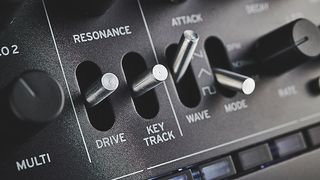
What should I look for in a cheap synth?
MusicRadar's got your back
The rise in affordable synths has made hardware instruments considerably more accessible to newer and less experienced producers. Many people find themselves wanting to interact with something physical, rather than simply tweaking the settings of a DAW, which makes hardware synths attractive. Not to mention they sound great, too. However, while the price is less daunting, some of the terminology can still make choosing a synthesizer feel quite intimidating.
Do I want an analogue synth?
One of the most common distinctions you’ll come across is that of ‘analogue’ vs ‘digital’ – meaning whether a synth is powered by ‘real’ electronic circuitry or some form of digital signal processing (DSP). While there are plenty of people out there who will claim that analogue automatically equals ‘better’, in reality this isn’t always the case. Trust your own ears.
On the whole though, it’s fair to say that synths powered by analogue engines or virtual analogue - digital tech replicating the behaviour of a real circuit - are better for classic and vintage sounds, while digital synths can often create weirder, more unusual tones.
Do I want a digital synth?
Digital synths will likely sound ‘cleaner’ compared to analogue synths that often generate a certain amount of unpredictability and natural saturation – both of which qualities are a major part of their enduring popularity. Some of the best cheap synths in this round-up take a ‘best of both’ approach, combining elements of analogue sounds with powerful digital elements.
Another term to look out for is polyphony, meaning how many notes a synth can play simultaneously. A polyphonic synth can play multiple notes via distinct synth ‘voices’, eg. a four-voice synth allows you to effectively play up-to four instances of the same synth sound at once to generate a chord. A monophonic synth, on the other hand, only has one voice available.
What's a paraphonic synth?
Slightly less common are paraphonic synths, which sit somewhere in between – these allow multiple notes to be played by dividing the oscillators within a single synth voice. The result isn’t quite the same as true polyphony, as individual notes will share a filter and amp envelope, however it does open up the possibility of playing certain chords or patterns that a monosynth wouldn’t be capable of.
Having more voices will always mean more flexibility, although monosynths often pack more of a punch when it comes to weight and grit. For leads, basslines, percussion or FX, a mono or paraphonic synth may be the way to go.
Find out more about how we test music gear and services at MusicRadar.
Are cheap synths worth it?
In our opinion, cheap - or budget - musical equipment has never been better. This guide proves just how many fantastic synths are on the market for a very reasonable price.
Better yet, these synths are made by some of the best names in the industry, with the likes of Korg, Roland, Yamaha and Moog offering stellar instruments that won't break the bank.
Suppose you are new to the somewhat intimidating world of synthesis. In that case, one of the best cheap synths is a perfect gateway into the art form, allowing you to experiment with new sounds without ruining your finances.
Related buyer's guides
- Bigger budget? These are the best sythesizers overall
- Explore the best semi-modular synths
- These are the best piano VSTs
- Our pick of the best cheap MIDI keyboards
- Create for less with the best budget laptops for music production
- Hardware vs software synths: which is better?
